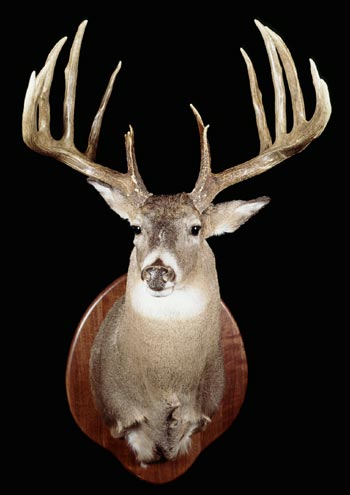Mel Johnson’s Illinois Beanfield Buck has stood as Pope and Young’s top-scoring typical for more than 45 years. Will this giant 12-pointer ever fall from bowhunting’s top spot?
By Les Davenport
 After arriving at a Peoria County farm on Friday afternoon, archer Mel Johnson of Metamora, Ill., nestled into some brush along a standing soybean field. It was Oct. 29, 1965, and three times on prior hunts he had seen a giant buck. Just before losing good shooting light, Johnson noticed the same huge-racked whitetail enter the field from woods almost 300 yards away. Wind in his face, he found it hard to believe the buck was walking steadily straight at him!
After arriving at a Peoria County farm on Friday afternoon, archer Mel Johnson of Metamora, Ill., nestled into some brush along a standing soybean field. It was Oct. 29, 1965, and three times on prior hunts he had seen a giant buck. Just before losing good shooting light, Johnson noticed the same huge-racked whitetail enter the field from woods almost 300 yards away. Wind in his face, he found it hard to believe the buck was walking steadily straight at him!
The diehard archer double-lunged the deer only a few bean rows from his spot of ambush. The rest is history. A 72-pound-draw Howett recurve, a fiberglass arrow tipped with a Zwickey broadhead, and a bit of luck put this Illinois resident and the renowned whitetail at the top of Pope and Young’s “Typical” category.
Nobody would have guessed that more than 45 years later it would not be topped!
As an avid archer from near Johnson’s hometown, I was not surprised when I got word of a new world record coming from Peoria County. This heavily timbered area near the Illinois River bluffs was known for big whitetails; it had just the right mix of agricultural ground for growing big, mature bucks. I was eventually hired on at Caterpillar where Johnson worked, but did not meet him until after becoming an outdoor writer. I, like most who became acquainted with Mel, admired him for his modesty, a trait rarely associated with today’s so-called whitetail “pros.”
The first scoring of Johnson’s buck tallied a net of only 194-4/8. Incredibly, the official scorer missed a 10-inch measurement! Once panel judged, the buck’s prior score was annulled and it was declared a new world record bow kill at 204-4/8. Nearly 40 years later, when I interviewed Mel at his home, he commented about the unbelievable odds of the deer still being No. 1.
Two facts make it hard for anyone to fathom this buck could still be on top: Whitetail numbers had exploded tenfold since the mid-60s, and advances in archery equipment had enabled a new, rapidly growing breed of archers — sportsmen who only hunted for trophies.
Odds Are?
Considering average annual permit sales nationwide and the number of P&Y whitetails entered each year, an archer’s odds of killing any typical or non-typical record-book whitetail with bow are approximately 15,000 to 1.
For tagging a Boone and Crockett-class buck with any weapon, the odds jump to about 80,000 to 1. When calculating the odds of an archer taking the next P&Y world-record typical during an upcoming season, the likelihood stymies the mind; it’s truly a million-to-one happening. To put things into perspective, during the Johnson buck’s 45-year reign, America has experienced 10 years of Vietnam War, two Gulf Wars and 10 presidents.
Yet, when critiquing the Johnson buck, the net main beam credits were less than 27 inches. More than half of P&Y’s Top 10 bucks have greater net beam length. And what about its 23⅝-inch inside spread? Although this is a stellar width for a whitetail, several bucks not even in the Top 10 surpass that measurement by 2 to 4 inches.
In regard to total tine length and mass, Mel’s buck falls well short of many other Midwest and Canadian world-class whitetails. Truthfully, had the Johnson, Hanson and Damery bucks been walking noses to tails past most archers, they’d have shot the Macon County, Illinois, Damery buck; it is more impressive than both the typical P&Y and B&C world-record deer.

Mainframe symmetry and the lack of abnormal points has been the deciding factor in keeping many world-class bucks from claiming the top typical spots in the two most-recognized scoring systems, P&Y and B&C.
What bolsters the odds for good symmetry? Two things: genetics and killing the buck before it reaches 6½ years of age.
The Johnson Buck was thought to be 4 or 5 years old, and the Hanson Buck might well have been only 3 or 4. Even with the genetic tendency to be typical, most white-tailed bucks begin sprouting abnormal points by age 6. At the suspected age of 5, the Damery Buck had already grown double brow tines totaling 14 inches. Without those abnormal points, it would have netted 2142/8 typical, or almost 10 inches more than the Johnson Buck and ⅝ inch better than B&C’s No. 1, the 213⅝-inch Hanson Buck.
Even with distinct genetics for symmetry, whitetails need exceptional year-round food sources and the ability to reach mid-age. The Johnson Buck field dressed at 270 pounds and had an estimated live weight of 340.
I was one of the first to put a tape on the Damery Buck, and although I don’t know the estimated or actual live weight, this deer was probably one of the most sleek, big whitetails I have ever laid eyes on. Brian Damery, like Johnson and Hanson, was a very modest and deserving hunter.
Who Will Be Next?
Lightning could have struck twice in the same spot. In November 1993, within spitting distance of where the Johnson Buck was dropped, gun hunter Jill Adcock shot a 4½-year-old 10-point that grossed 195-6/8 inches. This buck had great symmetry and no abnormal points. Unfortunately, five inches of tine length was missing due to a break. Had it lived another year and been taken by a bow-hunter … who knows!
Frankly, it’s a guessing game where the next world-record typical bow-kill could come from. It would only take a 3- or 4-year-old, 180-inch-net 6-by-6 to put on another 25 balanced inches in its next year. Considering today’s quality deer management trend, even the small state of Maryland has shown the potential to grow that one special whitetail. It’s unlikely a mainframe 5-by-5 will ever become the deer to accomplish this stature; although it’s not impossible. The former world-record Jordan Buck proves this theory.
Of course, the two most broad-based guesses for where the next P&Y world record will come from are Canada and the Midwest’s Corn Belt. There are definite constraints each region has for actually producing this extraordinary whitetail. In the Corn Belt, it’s a rare 180-inch typical that goes unnoticed; there are very few Midwest farms without 24-hour trail camera surveillance or an overabundance of archers, firearm hunters … and poachers. When calculating the minuscule percent of net 180-plus, 6-by-6 typicals that could grow to net 205 with one more year of life, point-blankly, they have very little chance of making it. Yet, if a buck of that caliber did live one more defining year, odds are that it would grow abnormal points.
Canada, on the other hand, has great expanses of unscathed forestland that would easily hide many world-record whitetails. However, the smaller number of archers, lower deer densities and cyclical winter kill greatly reduces the odds that Canada will produce anything more than another B&C record-topper.
So where will the next P&Y No. 1 come from?
Until 10 years ago, I’d have put my money on western Illinois. But after witnessing a decade of extremely poor DNR deer management and an overabundance of counterfeit outfitters in this part of the state, my new pick would be Ohio — where agriculture meets big woods.
Conscientious herd management by Buckeye State deer managers makes this a very probable pick. The one-buck limit and an aggressive approach to reducing poaching might well give that one young buck the chance it needs to become a top-all typical.
Truth Be Known
Pen breeders juggling genetics are definitely attempting to produce a new No. 1 in the typical category; it’s already been proven they can accomplish this in the nontypical class. Could you imagine what a straw of semen from a 214-inch 6-by-6 would be worth? The real problem here is not that a breeder would covertly allow a whitetail of this magnitude to be shot on film in the wild. Rather, selling that buck’s genetics to wealthy Texans for inseminating penned does later turned into the wild on large ranches would have the potential of creating a new world record with tampered ancestry.
For sure, word would eventually get out on a deer like this, and it would then be up to P&Y officials to make a ruling on eligibility. Without actual proof of a tainted pedigree, any suspect deer allowed to knock off the Johnson Buck would only serve to discredit the long-standing Pope and Young Big Game Records of North America. This would be a sad state of affairs.
With the jealousy experienced in the whitetail world, a new world-record typical bow-kill would be questioned no matter who claimed it. And could you guess the repercussions if a TV “pro” killed the next top typical? Only viewers who are now duped by some of these limelighters would believe the actual kill footage.
Final Thoughts
My only hope is that if Mel Johnson’s buck is beaten, it falls to an archer who is both deserving and humble. It would turn my stomach to see it killed on video and then hear, “Booyah! I think I just killed the next world record, baby!”
And, when an antler buyer comes around with his wallet open, I hope the lucky hunter sells him a replica and not the original rack. Of all the world-class whitetails I’ve written articles about during my 30-year writing career, most were sold to wealthy collectors. Within very little time, the money was gone and the sellers would just about give up their souls to get back the original set of antlers. A replica would simply not be the same to the hunter.
— Les Davenport is a veteran whitetail hunter from Illinois.
 Want to know some serious strategies for hunting top end bucks? Check out these resources from Deer & Deer Hunting:
Want to know some serious strategies for hunting top end bucks? Check out these resources from Deer & Deer Hunting:

Great perspective and a great history lesson for those of us not familiar with Mel. -Excellent article.